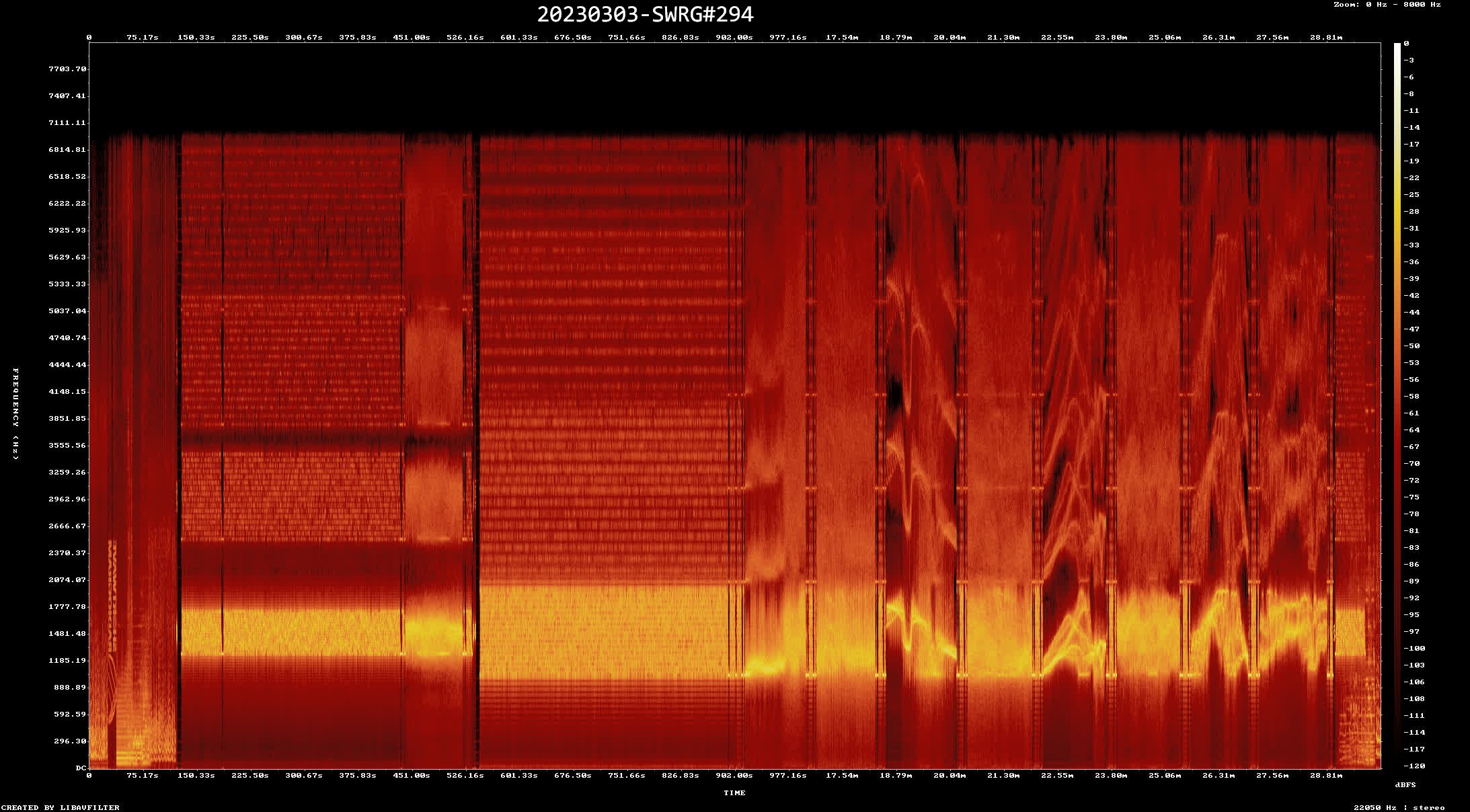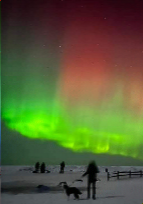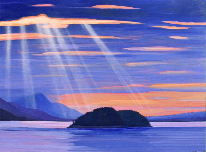http://www.rhci-online.net/radiogram/radiogram.htm
https://github.com/GyanD/codexffmpeg/releases/tag/2023-03-05-git-912ac82a3c
set MyFiles=*.flac *.wav *.aif *.mp4 *.mp3 *.mp2 *.aac *.ogg
for %%a in (%MyFiles%) do ffmpeg -i "%%a" -y -lavfi
showspectrumpic=s=1920x1080:color=fiery:gain=.7:fscale=lin:orientation=0:saturation=1:mode=combined:legend=enabled:start=0:stop=8000
"%%~na.jpg"


RSID: <<2023-03-03T00:31Z
MFSK-32 @
9265000+1500>>
Welcome to program 294 of Shortwave Radiogram.
I'm Kim Andrew Elliott in Arlington, Virginia USA.
Here is the lineup for today's program, in MFSK modes as noted:
1:34 MFSK32: Program preview (now)
2:39 MFSK32: Liquid nitrogen may remove Moon dust*
8:28 MFSK64: How to keep time on the Moon
14:26 MFSK64: This week's images*
28:31 MFSK32: Closing announcements
* with image(s)
Please send reception reports to
radiogram@verizon.net
And visit http://swradiogram.net
We're on Twitter now: @SWRadiogram
From New Atlas:
Liquid nitrogen may do the trick for getting moon dust off
spacesuits
By Ben Coxworth
February 28, 2023
If you've ever been to the Moon (and who hasn't?), then you'll
know that the clingy dust which covers its surface can damage
spacesuits. According to a new study, a spray of liquid nitrogen
may offer the best method of getting the stuff off – while
leaving suits intact.
Scientifically known as lunar regolith, moon dust isn't like most
natural dust here on Earth.
For starters, because it isn't subject to erosion by wind or
water, the fine particles are quite jagged and abrasive.
Additionally, because regolith is saturated with solar radiation,
it has a positive charge which causes it to cling to anything
with which it comes into contact.
On the Apollo moon missions, astronauts discovered that brushes
were quite ineffective at removing regolith from their spacesuits
– in fact, brushing just served to grind the dust in. Some of the
suits were actually rendered unusable after the regolith damaged
their seals.
Needless to say, the particles also aren't great for electronics
or engines. They even caused respiratory problems in some
astronauts, which persisted after they returned to Earth.
Seeking a more effective and less harmful alternative to brushing
and other proposed methods of regolith removal, scientists at
Washington State University recently looked to liquid nitrogen.
When an ultra-cold spray of the liquid was applied to warmer
samples of spacesuit material covered in simulated regolith, the
dust particles beaded up and floated away in the nitrogen vapor.
This reaction was due to what's known as the Leidenfrost effect,
in which a drop of liquid gets suspended above a surface by a
layer of vapor. It is what's at work when cold water beads up and
skitters across the surface of a hot frying pan.
The technique was tested both in normal atmospheric conditions
and in a vacuum similar to that in outer space. It worked in both
but performed better in the vacuum, where it removed 98.4% of the
dust particles.
Additionally, whereas just one brushing of the dust-covered
material samples damaged them, they stood up to 75 cycles of the
liquid nitrogen treatment before any damage was observed.
The scientists now plan on conducting further tests under
conditions which more closely simulate those on the lunar
surface. A paper on their research – which is being led by Assoc.
Prof. Jacob Leachman – was recently published in the journal Acta
Astronautica.
Source: Washington State University
https://newatlas.com/space/liquid-nitrogen-regolith-spacesuits/
See also:
https://phys.org/news/2023-02-liquid-nitrogen-spray-stubborn-moon.html
Sending Pic:300x266;

Shortwave Radiogram now changes to MFSK64 ...
RSID: <<2023-03-03T00:38Z
MFSK-64 @
9265000+1500>>
This is Shortwave Radiogram in MFSK64
Please send your reception report to
radiogram@verizon.net
From Phys.org:
Telling time on the moon
by European Space Agency
February 27, 2023
A new era of lunar exploration is on the rise, with dozens of
moon missions planned for the coming decade. Europe is in the
forefront here, contributing to building the Gateway lunar
station and the Orion spacecraft—set to return humans to our
natural satellite—as well as developing its large logistic lunar
lander, known as Argonaut. As dozens of missions will be
operating on and around the moon and needing to communicate
together and fix their positions independently from Earth, this
new era will require its own time.
Accordingly, space organizations have started considering how to
keep time on the moon. Having begun with a meeting at ESA's ESTEC
technology center in the Netherlands last November, the
discussion is part of a larger effort to agree a common 'LunaNet'
architecture covering lunar communication and navigation
services.
Architecture for joint lunar exploration
"LunaNet is a framework of mutually agreed-upon standards,
protocols and interface requirements allowing future lunar
missions to work together, conceptually similar to what we did on
Earth for joint use of GPS and Galileo," explains Javier
Ventura-Traveset, ESA's Moonlight Navigation Manager,
coordinating ESA contributions to LunaNet. "Now, in the lunar
context, we have the opportunity to agree on our interoperability
approach from the very beginning, before the systems are actually
implemented."
Timing is a crucial element, adds ESA navigation system engineer
Pietro Giordano: "During this meeting at ESTEC, we agreed on the
importance and urgency of defining a common lunar reference time,
which is internationally accepted and towards which all lunar
systems and users may refer to. A joint international effort is
now being launched towards achieving this."
Up until now, each new mission to the moon is operated on its own
timescale exported from Earth, with deep space antennas used to
keep onboard chronometers synchronized with terrestrial time at
the same time as they facilitate two-way communications. This way
of working will not be sustainable however in the coming lunar
environment.
Once complete, the Gateway station will be open to astronaut
stays, resupplied through regular NASA Artemis launches,
culminating in a human return to the lunar surface, progressing
to a crewed base near the lunar south pole. Meanwhile numerous
uncrewed missions will also be in place—each Artemis mission
alone will release numerous lunar CubeSats—and ESA will be
putting down its Argonaut European Large Logistics Lander.
These missions will not only be on or around the moon at the same
time, but they will often be interacting as well—potentially
relaying communications for one another, performing joint
observations or carrying out rendezvous operations.
Moonlight satellites on the way
"Looking ahead to lunar exploration of the future, ESA is
developing through its Moonlight program a lunar communications
and navigation service," explains Wael-El Daly, system engineer
for Moonlight. "This will allow missions to maintain links to and
from Earth, and guide them on their way around the moon and on
the surface, allowing them to focus on their core tasks. But
also, Moonlight will need a shared common timescale in order to
get missions linked up and to facilitate position fixes."
And Moonlight will be joined in lunar orbit by an equivalent
service sponsored by NASA—the Lunar Communications Relay and
Navigation System. To maximize interoperability these two systems
should employ the same timescale, along with the many other
crewed and uncrewed missions they will support.
Fixing time to fix position
Jörg Hahn, ESA's chief Galileo engineer and also advising on
lunar time aspects comments: "Interoperability of time and
geodetic reference frames has been successfully achieved here on
Earth for Global Navigation Satellite Systems; all of today's
smartphones are able to make use of existing GNSS to compute a
user position down to meter or even decimetre level.
"The experience of this success can be re-used for the technical
long-term lunar systems to come, even though stable timekeeping
on the moon will throw up its own unique challenges—such as
taking into account the fact that time passes at a different rate
there due to the Moon's specific gravity and velocity effects."
Setting global time
Accurate navigation demands rigorous timekeeping. This is because
a satnav receiver determines its location by converting the times
that multiple satellite signals take to reach it into measures of
distance—multiplying time by the speed of light.
All the terrestrial satellite navigation systems, such as
Europe's Galileo or the United States' GPS, run on their own
distinct timing systems, but these possess fixed offsets relative
to each other down to a few billionths of a second, and also to
the UTC Universal Coordinated Time global standard.
The replacement for Greenwich Mean Time, UTC is part of all our
daily lives: it is the timing used for Internet, banking and
aviation standards as well as precise scientific experiments,
maintained by the Paris-based Bureau International de Poids et
Mesures (BIPM).
The BIPM computes UTC based on inputs from collections of atomic
clocks maintained by institutions around the world, including
ESA's ESTEC technical center in Noordwijk, the Netherlands and
the ESOC mission control center in Darmstadt, Germany.
Designing lunar chronology
Among the current topics under debate is whether a single
organization should similarly be responsible for setting and
maintaining lunar time. And also, whether lunar time should be
set on an independent basis on the moon or kept synchronized with
Earth.
The international team working on the subject will face
considerable technical issues. For example, clocks on the moon
run faster than their terrestrial equivalents—gaining around 56
microseconds or millionths of a second per day. Their exact rate
depends on their position on the moon, ticking differently on the
lunar surface than from orbit.
"Of course, the agreed time system will also have to be practical
for astronauts," explains Bernhard Hufenbach, a member of the
Moonlight Management Team from ESA's Directorate of Human and
Robotic Exploration. "This will be quite a challenge on a
planetary surface where in the equatorial region each day is 29.5
days long, including freezing fortnight-long lunar nights, with
the whole of Earth just a small blue circle in the dark sky. But
having established a working time system for the moon, we can go
on to do the same for other planetary destinations."
Finally, to work together properly, the international community
will also have to settle on a common 'selenocentric reference
frame', similar to the role played on Earth by the International
Terrestrial Reference Frame, allowing the consistent measurement
of precise distances between points across our planet. Suitably
customized reference frames are essential ingredients of today's
GNSS systems.
"Throughout human history, exploration has actually been a key
driver of improved timekeeping and geodetic reference models,"
adds Javier. "It is certainly an exciting time to do that now for
the moon, working towards defining an internationally agreed
timescale and a common selenocentric reference, which will not
only ensure interoperability between the different lunar
navigation systems, but which will also foster a large number of
research opportunities and applications in cislunar space."
Provided by European Space Agency
https://phys.org/news/2023-02-moon.html
This is Shortwave Radiogram in MFSK64
Please send your reception report to
radiogram@verizon.net
This week's images ...
Spawning coral in the Red Sea. Winner of the World Nature
Photography Awards.
https://t.ly/RFZc ...
Sending Pic:141x200C;

Magnolias in Rawlins Park, Washington DC, March 1.
https://t.ly/hz2M ...
Sending Pic:193x142C;

Cherry tree buds on the Tidal Basin, Washington DC, March 1.
https://t.ly/DiIP ...
Sending Pic:195x168C;

A daffodil on T Street NW in Washington DC, February 28.
https://t.ly/Bnhg ...
Sending Pic:172x175C;

The northern lights as seen from McLain State Park near Houghton,
Michigan, February 26.
https://t.ly/3ovk ...
Sending Pic:143x204C;

A cardinal in a cherry tree in Washington DC, February 23.
https://t.ly/Ji1Wo ...
Sending Pic:199x147C;

Sunrise at Yellowstone National Park, which was founded March 1,
1872.
https://bit.ly/3kAUW8P ...
Sending Pic:123x216C;

Our painting of the week is "View from BC Ferries" (2020) by
Nicholas Bott.
https://bit.ly/3m9xoIk ...
Sending Pic:206x152C;

Shortwave Radiogram returns to MFSK32 ...
RSID: <<2023-03-03T00:58Z
MFSK-32 @
9265000+1500>>
This is Shortwave Radiogram in MFSK32 ...
Shortwave Radiogram is transmitted
by:
WRMI, Radio Miami International, wrmi.net
and
WINB Shortwave, winb.com
Please send reception reports to
radiogram@verizon.net
And visit http://swradiogram.net
Twitter:
@SWRadiogram or twitter.com/swradiogram
I'm Kim Elliott. Please join us for the next Shortwave
Radiogram.
https://jadquir.xyz/pages/mra/index.html#about

https://youtu.be/RPgE991VDwM
https://www.theguardian.com/music/2023/feb/23/chuck-jackson-obituary
https://en.wikipedia.org/wiki/Chuck_Jackson

http://www.rhci-online.net/radiogram/radiogram.htm
http://wiki.radioreference.com/index.php/Decoding_the_SW_Radiogram_Broadcasts
https://www.qsl.net/ve7vv/Files/Digital%20Modes.pdf

RSID: <<2023-03-05T23:30Z
MFSK-64 @
5950000+1500>>
Edmond “Eddy” Grant was born March 5,
1948
Sending Pic:182x240;

http://www.eddygrant.com/
Please report your decode to
themightykbc@gmail.com














